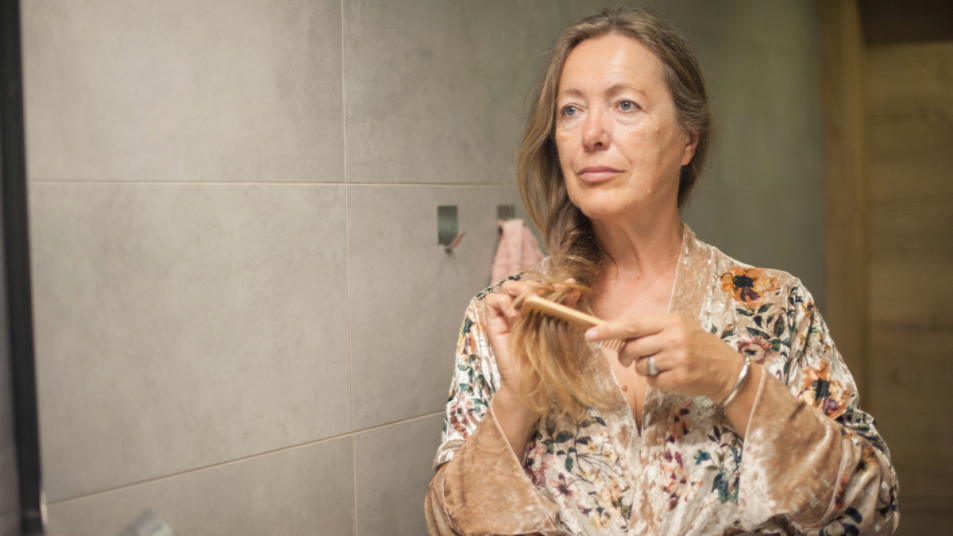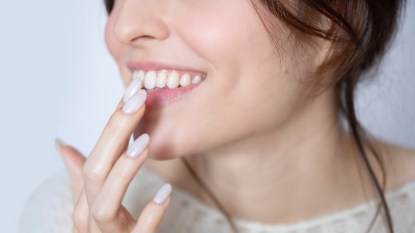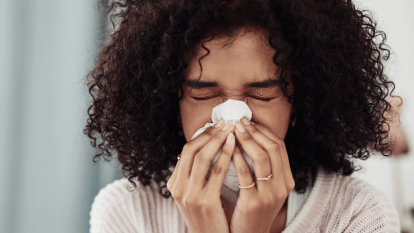9 Ways to Fight Perimenopause Hair Loss

As we age, it can be embarrassing to admit we may be experiencing menopause or perimenopause hair loss. I saw this just recently when I met up with my friend Emily for coffee.
After we sat down with our iced lattes, I was surprised that she didn’t take off her winter wool beanie. “What’s up?” I said, nodding toward her hat.
“Oh, just chilly,” she said, not at all convincingly. Soon the skin above her brows began to perspire.
“You sure you’re okay?”
She leaned in closer. “You’re writing about perimenopause, right?” I nodded. I couldn’t imagine what she was going to say. She had found some weird, counterintuitive cure for hot flashes that included the wearing of heavy woolen headgear? She had (God forbid) some terrible disease? “I think I’m going bald,” she whispered, “and I think it has to do with hormones.”
“Oh,” I said, relieved. “Is that all?”
“What do you mean is that all? I said I think I’m going bald!” she shouted. The two undergrads studying for finals at the nearby table glanced at us, and then, embarrassed, looked away.
“I mean, that’s normal. I thought you were sick. Take off your hat. Let me see.”
How do you know you’re dealing with perimenopause hair loss?
Emily took off her hat. Her blond shoulder-length hair was thinning, but she was hardly bald. But then again, her hair was wet and stringy from sweat, which wasn’t doing anything for her. “I think I may have a diagnosis.”
“I knew it!”
“Remember how when you were pregnant, and your hair came in all thick and glossy? That’s because you had all kinds of estrogen. This is the opposite of that. You’re losing estrogen, and so you’re losing a little hair.”
“What can I do?”
“I said I had a diagnosis. Not a cure.”
Emily put her wool beanie back on. “Some doctor you are.”
I explained to Emily that The Iowa Writers’ Workshop wasn’t really in the business of handing out medical degrees. But since my hair was also thinning, and since I was curious, and since I supposed we weren’t the only two women on the planet who wanted some answers, I’d do some perimenopause hair loss research.
Here are nine ways you can handle hair loss during perimenopause.
1. Find out if a medical issue is causing your hair loss.
Perimenopause is a natural state of aging, but hair loss can be a symptom of a more serious problem. The first thing you should do if you’re experience hair loss is see your doctor to make sure you don’t have a health issue (such as anemia, lupus, or hypothyroidism).
Once you and your doctor have determined that your hair loss is caused by perimenopause, it might be time to try out some other treatments. (Be sure to get your doctor on board, too!)
2. Consider adding hormones.
If we are experiencing hair loss or thinning hair because our female hormones are in decline, then it only makes sense that replacing estrogen and progesterone through the hair growth supplements and hair loss products might help.
Another treatment option might be low-androgen index birth control pills. (High-androgen birth control pills can create more hair loss.)
3. Try a hair regrowth product.
Minoxidil, the generic name for the topical over-the-counter treatment many people know as Rogaine, has been shown to provide some regrowth of hair or prevent further hair loss. Rogaine now comes in a five percent foam for women, which is to be applied once a day, and must be used indefinitely; if you stop using it, hair loss will recur.
Some studies have shown that about 20 percent of women experience moderate regrowth of hair and about 40 percent experience some regrowth of hair after four months of use; results are best for women who start the treatment as soon as they start to experience hair loss.
4. Wash your hair less frequently.
Experts seem to agree that nobody needs to wash her hair every day. It’s not that washing our hair makes it fall out (though it may appear that way; we lose an average of 80 strands of hair a day, and it may seem that we lose all 80 of those strands in the shower when we’re shampooing in the morning), but experts say that what we do to our hair afterwards can damage it.
For example, using blow dryers and curling irons on high heat settings and extra-hold hair spray can all create hair loss. The trick is to let our hair dry naturally or wash and style it less often.
5. Go for regular massages.
Sometimes I want to call one of the fancy hair salons in Madison and say, “I want a cut and color but skip the cut and color.” The receptionist will say, “You mean you want a shampoo with a head massage?” And I’ll say, “Yes, exactly!”
Turns out I may be on to something. Research shows that if scalp massages are done with essential oils, including lavender, cedarwood, thyme, and rosemary (the latter being especially effective), they do indeed stimulate hair growth.
Of course, the nice thing is, we don’t need to embarrass ourselves by making crazy requests to fancy hair salons (although, if the salon is fancy enough, of course, no request will be seen as crazy); we can give scalp massages to ourselves. And if your sleeping partner doesn’t care, or if you sleep by yourself, then for an additional benefit, you can do what I sometimes do, which is rub rosemary oil with coconut oil into my scalp before bed, and then sleep with it in my hair/head all night. Just make sure you wash it out again before you leave in the morning.
6. Consider changing your hair style.
There are certain styles and cuts that are especially flattering for women with thinning hair.
Cuts: Long hair can weigh down fine hair. Stylists recommend that women with thinning hair get frequent trims and that they add layers for volume. One especially flattering cut to try is a choppy bob; another is a pixie. Uneven bangs can create depth and texture.
Color: Lowlights and highlights can add depth and dimension, which can make hair look more full. Lighter hair can make a visible part and scalp look less pronounced.
Styles: If you always part your hair on the right, try parting it on the left for added volume. A jagged part can hide a visible scalp, and can also make the top layers stick up, as if you’ve teased your hair. Blow drying creates volume as well. Loose waves, created with a diffuser and sea salt spray, can make hair appear thick and bouncy. So can curling your hair. A half-pony (think “Sleeping Beauty”) with the bottom half curled or left straight, and the top pulled up high, adds fullness and height. African-American women with thinning hair may want to try side bangs, twist outs, and updos with cascading hair and bangs, using the hair you have to cover the thinning spots.
7. Talk to your doctor about cortisone shots or acupuncture for perimenopause hair loss.
The data is inconclusive as to whether or not cortisone shots actually work at re-growing hair, but I do know one woman who gets them frequently and says they have really helped her. Cortisone shots are given at the scalp, and the Mayo Clinic suggests they should not be given more often than every six weeks.
While I know of some women who have had luck with acupuncture for hair loss, the British Acupuncture Society states that there is no evidence that acupuncture can treat hair loss as a specific symptom; however, it might help with the underlying problem. (For example, acupuncture can help treat lupus, which can cause hair loss.)
8. Try a few key supplements.
If you’re wondering what vitamins are good for hair loss during menopause, there are a few key nutrients you need. Biotin and Viviscal, for example, come up again and again in perimenopausal hair loss research. Deficiencies in biotin are rare, but many women take supplements because it seems to improve the condition of their hair and nails.
Viviscal has Biotin in it — and calcium. And vitamin C. It also contains shark cartilage, oyster extract, and a “marine complex” — which is apparently the secret elixir that gives the ingredient its power. The U.S. National Library of Medicine published an article with a double-blind placebo controlled study that showed the efficacy of this product; “significantly more” women who took Viviscal than the placebo noticed hair growth after 90 days, and even more after 180 days.
Now it’s true that the funding for the study was provided by the makers of Viviscal, but double-blind is double-blind. Furthermore, in an entirely separate article, Beauty Editor writer Katrina Persad tried Viviscal for six months and documented her results in a quite convincing photo essay and article that showed fairly dramatic results — and Viviscal (as far as I know) did not pay her for her trouble.
Check out this list of nutrients for hair loss, and where you can find them.
9. Embrace your hair loss during perimenopause.
I called my friend Emily when I had finished all of my research, excited about all of the things we could do for our thinning hair. I went down my list, ticking everything off, explaining, elucidating, answering questions before she could even ask them. When I was finished, I let out a deep breath, and said, “Well, I guess that’s it.”
There was a long pause.
“Hello?” I said. “Em? Are you there?”
“Yes, I’m here, but the question is, are you all there?”
“What are you talking about?”
“That sounds totally exhausting and really expensive. Forget it! You know what I’m doing? I’m getting a summer hat! I saw a really cute one when I was at the mall, but it was like $50, and I thought, that’s crazy, I’m not spending fifty bucks on a stupid straw hat! Now that seems like a total bargain to me! I’m just going to wear hats all the time! Wool hats in winter, straw hats in summer. It’ll be an investment I’ll make every couple years. Done! Thank you, Kelly, you have made me realize I don’t need to solve this problem, I just need to keep covering it up.”
“Umm, you’re welcome?”
But Emily had already hung up, apparently impatient to get on her with her life and get to the mall. I didn’t even know Emily frequented malls.
But if there’s one thing I’ve learned, it’s that perimenopause changes us all.
This essay was originally written by Kelly Dwyer, a published novelist, playwright, and freelance writer.













